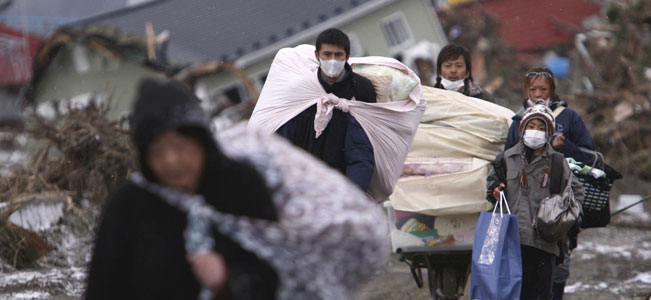YAMAGATA, Japan – Emergency workers frantic to regain control of Japan's dangerously overheated nuclear complex turned to increasingly elaborate methods Thursday to cool nuclear fuel rods at risk of spraying out more radiation.Click Here!
They tried with police water cannons, heavy-duty firetrucks and military helicopters dropping bucket after enormous bucket of water onto the stricken system.
By nightfall, it wasn't clear if anything had worked, and the U.N.Click Here! nuclear agency warned the situation was "very serious."
U.S.Click Here! and Japanese officials gave differing assessments of what was happening at the Fukushima Dai-ichi nuclear plant, 140 miles (220 kilometers) north of Tokyo.Click Here! The top U.S.Click Here! nuclear regulatory official warned of possible high emissions of radiation while the U.S.Click Here! ambassador urged Americans within 50 miles (80 kilometers) of the plant on the tsunami-savaged northeastern coast to leave the area or at least remain indoors.Click Here!
Tokyo Electric Power Co., which owns the plant, said it believed workers were making headway in staving off a catastrophe both with the spraying and, especially, with efforts to complete an emergency power line to restart the plant's own electric cooling systems.Click Here!
"This is a first step toward recovery," said Teruaki Kobayashi, a facilities management official at the power company. He said radiation levels "have somewhat stabilized at their lows" and that some of the spraying had reached its target, with one reactor emitting steam.Click Here!
"We are doing all we can as we pray for the situation to improve," Kobayashi said. Authorities planned to spray again Friday, and Kobayashi said: "Choices are limited. We just have to stick to what we can do most quickly and efficiently."
The troubles at the nuclear complex were set in motion by last Friday's 9.Click Here!0-magnitude earthquake and tsunami, which knocked out power and destroyed backup generators needed for the reactors' cooling systems.Click Here! That added a nuclear crisis on top of twin natural disasters that likely killed well more than 10,000 people and left hundreds of thousands homeless.Click Here!
Four of the plant's six reactors have seen fires, explosions, damage to the structures housing reactor cores, partial meltdowns or rising temperatures in the pools used to store spent nuclear fuel.Click Here! Officials also recently said temperatures are rising in the spent fuel pools of the last two reactors.Click Here!
Two Japanese military CH-47 Chinook helicopters began dumping seawater on the complex's damaged Unit 3 on Thursday morning, defense ministry spokeswoman Kazumi Toyama said. The choppers doused the reactor with at least four loads of water in just the first 10 minutes, though television footage showed much of it appearing to disperse in the wind.
Click Here!




